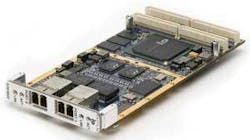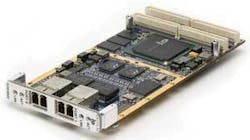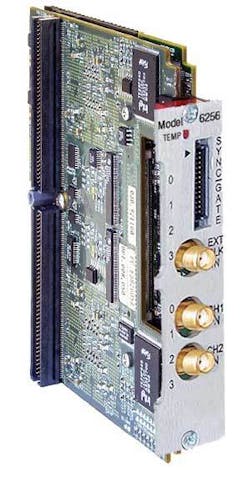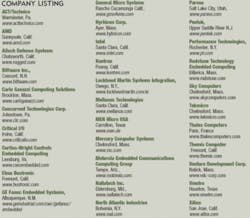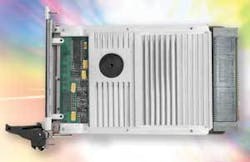Advanced I/O means Ethernet
Military designers are excited about the I/O capabilities that 10-Gigabit Ethernet promises to bring to the table.
By John McHale
Ethernet, thanks to its longevity and abundant product base, is becoming the defacto choice for advanced-I/O and switched-fabric applications for military systems. The standard 100-gigabit Fast Ethernet is a staple of many designs and 10-gigabit Ethernet products are in development.
In three to five years 10-Gigabit Ethernet will be everywhere, says Eran Strod, director of product marketing for the Mercury Computer Systems Defense Business unit in Chelmsford, Mass.
Where the Rapid IO switched fabric will connect box to box and work through backplanes, 10-Gigabit Ethernet will be the solution that connects systems, Strod says, explaining that Rapid IO is good at the type of traffic management necessary for board to board. Mercury was the major force behind the development of the Rapid IO standard.
The speeds that 10-Gigabit Ethernet can handle and its prevalence make it the ideal choice for designers working on network-centric warfare applications where throughput without bottlenecks is a necessity, Strod says.
Ethernet is everywhere and its advanced lifecycle and roadmap for improved performance cannot be beat, says Jack Staub, president of Critical I/O in Irvine, Calif. That trend is not only true for commercial systems but military ones as well, Staub says.
InfiniBand, in contrast, does not have the leverage that Ethernet has in the market and will probably not end up being as popular, Staub says.
Rapid IO and 10-Gigabit Ethernet also benefit from having remote direct memory access (RDMA), says Ray Alderman, executive director of VITA in Fountain Hills, Ariz. RDMA allows data to move directly from the memory of one computer into that of another, improving throughput.
The future of advanced I/O solutions is more of an effect of the war between centralized processing and distributed processing, Alderman says.
Intel is PC centric and wants all decisions made by one processor, where all the I/O is routed through the single CPU decision maker. This explains the company’s new Dual Core initiative, which enables several processor cores on one board.
Intel just started releasing chips based on its Core Microarchitecture, which it claims improves performance while reducing wattage and heat. AMD is addressing the power and cooling needs with its line of Multi-Core solutions. Whereas AMD and IBM and Freescale use multiple processors with specific responsibilities and the I/O is distributed between them, Alderman says.
Silicon stack
Critical I/O’s XGE Silicon Stack TCP/IP Offload Engine (TOE) PCI mezzanine cards (PMCs) are designed for data-intensive real-time applications and are already being used on military platforms such as the Lockheed Martin C-130 turboprop aircraft. The XGE hardware features a silicon stack that implements TCP/IP offload in silicon, providing the highest performance, low host-CPU loading, and deterministic operation. This level of performance is not available with processor-based solutions, Staub says.
Competing PMC TOE solutions are often, in reality, simply processor-based PMCs that use a standard CPU running a standard software TCP/IP stack, along with a standard non-TOE Ethernet NIC, Staub says. “While these types of PMCs do serve to offload TCP/IP processing from the host processor, they do not offer the low latency and consistently high and deterministic performance that XGE Silicon Stack TOE provides,” he adds.
TOE technology is enabling the use of Gigabit Ethernet in many data-intensive real-time systems. “But all TOEs are not created equal,” Staub says. “The two main approaches used to implement TOE PMCs for higher-performance systems are processor-based TOE and full-hardware-based TOE, such as Critical I/O’s XGE Silicon Stack Ethernet products.
Processor-based TOE PMCs are basically full processor PMC boards (CPU, memory, bridges, etc.) that implement a traditional TCP/IP stack in software that runs on a general-purpose CPU, perhaps embedded in a field-programmable gate array (FPGA), he explains.
This approach “does little to help with the high latency, poor determinism, and unpredictable performance normally associated with Ethernet,” Staub says. “This is because processor-based approaches suffer from the same basic problem as traditional Ethernet implementations, namely the reliance on a TCP/IP software stack, and the stack’s complex interaction with traditional Ethernet NIC hardware.”
Low latency and deterministic full-hardware TOE, such as Critical I/O’s XGE Silicon Stack Gigabit Ethernet hardware, is for real-time applications. The XGE hardware implements full TCP/IP offload in silicon. Full offload provides high performance, very low CPU loading, and “perhaps most important for real-time systems, highly deterministic operation and consistently high data rates, Staub says.
“There are many advantages in using Gigabit Ethernet in data-intensive real-time systems,” Staub says. “The use of 1 and/or 10-Gigabit Ethernet allows interoperability with a wide variety of standard, low-cost Ethernet hardware and protocols, while the incorporation of effective TOE PMC technology allows ultra-high-performance operation where needed.”
XGE Silicon Stack Ethernet is available in 1-gigabit versions today, with 10-gigabit versions available soon.
VITA 41 and VITA 46
Two VITA standards-VITA 41 and VITA 46-address I/O concerns through their ability to work with switched fabrics. VITA 41 products, also known as VXS, are already shipping to customers while VITA 46 has yet to mature to the same level as VITA 41.
“VXS is ideal for streaming I/O applications where huge computing architectures are not needed,” Alderman says. VXS enables VMEbus architectures to use switched fabrics with training wheels on. VITA 41 and VXS are very software friendly where fabrics are not yet. The technology enables extensive debugging that can’t be done with fabrics.
Alderman says the VITA 46 standard is moving along nicely, but they are still working out the physics behind it.
“I think of VITA 46 as a supercomputing architecture. It allows military designers to take advantage of high-density switched fabrics such as Serial Rapid I/O, 10-gigabit Ethernet, InfiniBand, etc.,” he says. “It also allows for liquid cooling in addition to conduction and convection. Liquid cooling will be necessary due to all the heat these high-performance devices will generate.”
VITA 46 will still be VME as long as the application uses VME; otherwise it will take the form of a pure fabric architecture, he adds.
VXS definitely has flexibility, says Rodger Hosking, vice president of Pentek in Upper Saddle River, N.J. It can take advantage of switched fabric technology and work with double-digit backplane partitions or work with as little as three-for those customers who do not need all those slots, he adds. VITA 46, which is targeted for large computing systems, does not lend itself to the smaller configuration, Hosking notes.
FPGAs and I/O
Pentek is shipping product with VXS technology and IP Cores on FPGAs, Hosking says, adding that FPGAs enable improved I/O efficiencies by their rocket I/O transceivers.
Pentek offers a high-performance, software radio front-end with two 105 MHz 14-bit A-D converters and two user-configurable Virtex-II Pro FPGAs. This VIM-2 module targets compute-intensive engines found in applications such as real-time wideband processing, radar, and wireless applications. As many as two Model 6256’s mount on Pentek’s VIM baseboards featuring the Texas Instruments C6000s or Motorola’s G4 PowerPCs while maintaining a single-slot configuration. This single-slot, dual 6256 combination boasts four A-D channels and 24 million FPGA gates.
This module offers a second-slot option to increase the number of A-D channels to as many as eight without requiring an additional baseboard. In addition, the Model 6256 can be combined with compatible commercial-off-the-shelf (COTS) PMC and VIM I/O modules, including high-speed A-Ds, D-As, digital upconverters, digital down converters, and various digital I/O modules such as FPDP-II, Hosking says.
“The Model 6256 extends the processing power and gate density of our most popular board-the Model 6236-by as much as four times the horsepower. By boosting the base system to four A-D channels with the power of the Virtex-II Pro FPGAs, we offer our customers the highest-density board in the industry,” Hosking notes. “Plus, the 6256 system configurations are extremely flexible, allowing two to eight A-D channels and 12 to 24 million FPGA gates, depending on the needs of the user. This allows customers to pay only for what they need in their system.”
Intellectual-property (IP) cores or FPGAs are the future for the main reason “that they eliminate the obsolescence problem that the commercial-off-the-shelf (COTS) initiative gave us,” Alderman says. “COTS brought a lot of wonderful things such as low prices but obsolescence was the bad side effect.
“IP cores, which are placed on FPGAs, relieve designers of the stress that comes when a chip designer such as Intel ends the life of a product,” Alderman explains. “Now they can keep that chip technology on a core. It is much like a Linux model where you can own the source code. IP cores allow designers to control their own destiny, plan on 10- to 15-year lifecycles, and get all the advantages of COTS chips without the disadvantage of obsolescence.”
FPGAs might cost more but their advantages in improved efficiency and reconfigurability are worth it, says Andy Reddig, president of Tek Microsystems Inc. (Tekmicro) in Chelmsford, Mass. Reddig’s designers take advantage of FPGA capabilities with their JazzFiber Quad Serial FPDP PMC module, which is the first member of Tekmicro’s new family of JazzFiber FPGA-based multiprotocol fiber-optic I/O modules. The JazzFiber PMC combines the advantages of the ANSI/VITA 17.1 Serial FPDP interconnect with highly integrated FPGA technology to provide channel density and throughput in a single PMC module.
Serial FPDP provides fast, low latency point-to-point or broadcast connections between sensors and processing systems at data rates as fast as 247 megabits per second. The JazzFiber module supports four independent Serial FPDP interfaces along with sufficient memory bandwidth for full throughput buffering of 1 Gigabit of data. An FPGA-based PCI core supports legacy PCI 2.3 functionality at 33 MHz along with PCI-X at 66, 100, and 133 MHz for aggregate throughput of as fast as 1,067 megabits per second. Future modules will support VITA 42 XMC platforms with compatible FPGA and software APIs.
Mercury’s PowerStream 7000 FPGA compute node (FCN) module provides a flexible way to harness the power of field-programmable gate arrays (FPGAs) in PowerStream 7000 multicomputer systems.
The PowerStream 7000 FCN (FPGA Compute Node) can incorporate as many as 69 Xilinx 7-million-gate FPGAs connected by a RapidIO switched fabric, enabling twice the processing performance in the same system footprint. Mercury officials recently delivered the PowerStream 7000 FCN to Lockheed Martin for use with the Aegis weapon system aboard U.S. Navy Ticonderoga-class cruisers and Arleigh Burke-class destroyers.
“Processing speed is critical to the sailors who rely on our systems when they sail in harm’s way,” says Jim Judd, director of processor and digital systems design at Lockheed Martin’s MS2 business. “In addition to speed, we continue to seek solutions that use less space on ships and take advantage of open architecture design.”
The reconfigurable computing option includes as many as 46 10-gigabit fiber connections directly to the FPGAs, in addition to the 320 gigabits per second of I/O available in the base configuration. With this combination of massive computing and I/O capability, the PowerStream 7000 FCN is designed to solve tough signal and image processing challenges in high-end intelligence, surveillance, and reconnaissance applications, Mercury officials say.
“Customers deploying advanced applications in a number of areas have found FPGAs to be a great processing complement to improve performance within their target size, weight, or power envelope,” says Craig Lund, vice president and chief technology officer. Customer interest for reconfigurable systems has been for synthetic aperture radar, ground-moving target indicator applications, low-latency IP packet analysis and reconstruction for signals intelligence, and other areas, he adds.
The base configuration of the PowerStream 7000 system uses PowerPC 7447A processors connected by a RapidIO switched fabric. The PowerStream 7000 FCN configuration can be integrated for front-end signal processing in the same system with PowerPC processors, using PowerStream FCN boards. The FCN board has three 7-million-gate Xilinx FPGAs, each with SRAM, DRAM, a dedicated RapidIO link, and high-speed copper links both to the front panel and to the other FPGAs. Two of the FPGAs also have a 10-gigabit fiber connection to the front panel, which can be used for 10-Gigabit Ethernet.
The power of the FPGAs is accessed through Mercury’s FCN Development Kit (FDK). The FDK provides the RapidIO interface, multi-ported memory interfaces, I/O interfaces, and an on-chip fabric to connect them all. The components work together to provide high-bandwidth data paths across the entire chip and memory mapping across the RapidIO fabric.
I/O offerings
AdvancedIO Systems Inc., maker of configurable 10-Gigabit Ethernet (10GbE) connectivity and packet processing solutions for the embedded computing market in Vancouver, British Columbia, has received a purchase order to supply a 10GbE packet processing solution to VMETRO in Houston. AdvancedIO’s solution is integral to VMETRO’s Vortex data recording system, which was recently selected by a major U.S. Defense Contractor. AdvancedIO will be supplying its V1010 modules, based on Xilinx FPGAs, and custom development of a packet-processing application. This initial purchase order is valued at approximately $200,000, with additional orders expected over the next two years.
Officials at Curtiss-Wright Controls Embedded Computing in Leesburg, Va., announced the S/DCP3-1201, a 3U CompactPCI single board computer (SBC) that features Intel’s 1.67 GHz Core Duo processor. The Core Duo’s low voltage operation improves embedded system performance per watt and is ideal for defense and aerospace platforms in which size, weight, and power are critical, Curtiss-Wright officials say. The S/DCP3-1201 can be configured with either Intel Core Duo or Core Solo CPUs, and is available in air and conduction-cooled configurations.
“The S/DCP3-1201 combines Intel’s most advanced low-power x86 technology with unmatched I/O flexibility, raising the bar for high performance space and weight constrained embedded computing applications.” says Lynn Patterson, vice president and general manager of Curtiss Wright’s Modular Solutions group.
Thales in Paris introduced its PENTXM2, a server class manageable VMEbus blade that uses the low-power Intel dual-core Xeon processor. The PENTXM2 uses the 1.67 GHz dual-core Xeon, Intel’s most advanced low-power x86 technology, combined with the Intel E7520 server class memory controller hub (MCH). The PENTXM2 is available with as much as 4GB of DDR2-400 SDRAM. When paired with the support of VITA 31.1 backplane networking, the PENTXM2’s VITA 38 intelligent platform management interface (IPMI) feature provides for easy scaling into a multiprocessing system. The PENTXM2 provides a dual SATA-150, a triple USB 2.0 port and an EIDE interface for an on-board disk or compact-flash support.
The PENTXM2’s low size, weight, and power make it well suited for naval and aerospace programs, says Alain Albarello, general manager of Thales’ computer activities. “The combination of the PENTXM2 with dual-head graphics XMC significantly upgrades the graphics performance of naval and airborne consoles to a point where users can implement new features such as multihead display and high-resolution video grabbing,” Albarello adds.
Radstone provides Rugged 3U VPX
Radstone Embedded Computing in Billerica, Mass., announced rugged VPX boards based on the 3U form factor. The new family comprising an Intel Pentium-based single board computer, a graphics accelerator platform and a Gigabit Ethernet switch-marks the first of what Radstone expects to be numerous VPX announcements in the coming months. The company will also announce a family of rugged VPX boards based on the 6U form factor later this year.
The device’s small size and low weight is an advantage especially in future platforms such as unmanned vehicles, Radstone officials say. With growth expected to be driven by programs such as the U.S. Army Future Combat System (FCS), higher integration levels mean that performance is not compromised by the smaller form factor and heat/power dissipation remains within today’s thermal performance envelope, company officials say.
Radstone’s initial VPX product offering includes a range of platforms. The SBC340 is based on the 65nm 2.0 GHz Core Duo T2500 (‘Yonah’) processor which is the successor to the Pentium M processor from Intel and is for minimal power consumption. It features the 945GM Northbridge chip set, and takes full advantage of PCI Express’s 16x throughput. The GRA110 graphics board also features x16 PCIe, and supports dual channel video output. The GBX410 Gigabit Ethernet Switch is based on Radstone’s CPX24, and features twelve Gigabit Ethernet channels and one 10-Gigabit Ethernet channel to the backplane. All three boards are expected to ship this fall.
Aitech completes delivery of first production lot of ALH display and mission computers
Engineers at Aitech Defense Systems in Chatsworth, Calif., have delivered the first production lot of 30 display and mission computers (DMCs) that drive the state-of-the-art glass cockpit avionics of the Indian Advanced Light Helicopter (ALH) Program to the LAHAV Division of Israel Aircraft Industries (IAI).
The ALH helicopter is designed and built by Hindustan Aeronautics Limited (HAL). IAI/LAHAV is under contract to HAL to develop and provide the avionics system for this aircraft.
The DMC is a cooperative design effort of IAI/LAHAV and Aitech that will provide IAI commercial-off-the-shelf (COTS) and open-systems -architecture-compliant, integrated and tested DMC systems. Aitech will build and deliver 400 DMC units for the ALH program over the next several years.
Aitech is also under contract to IAI to provide the next generation of the digital map module (DMM), which will be part of the DMC. With the additional functionality of the DMM module, the DMC will become a complete avionics computer, providing the performance needed by the IAI LAHAV division for its current and future avionics upgrade programs.
The DMC is an avionics computer that includes processor, memory, I/O, and quad-head graphics boards packed in a lightweight 1 ATR short enclosure with a sophisticated MIL-STD-704-compliant power supply.
The DMC was designed to run the display and mission management software developed by IAI/LAHAV and is designed to be DO-178B-compliant. It is capable of driving four digital (DVI) MFDs (multi-function displays) simultaneously, displaying high-resolution synthetic graphics with instrumentation, navigation and mission data, as well as multiple sources of video, Aitech officials say. The graphics/video subsystem supports many different configurations and protocols in addition to input and display options, thus providing IAI/LAHAV the best performance and maximum flexibility to implement advanced glass cockpit systems.
The DMC also includes a large array of communication interfaces, including MIL-STD-1553, ARINC 429, Fast Ethernet, USB (for external removable mass storage devices), high speed RS-422/485/232 serial I/O and high quality audio as well as support for ARINC 708 weather radar equipment. A large number of digital and analog (A-D, D-A) input and output lines used to read and control different sensors are also integrated into the computer.
Ethernet continues to gain traction in industrial distributed/remote I/O applications
The worldwide market for industrial distributed/remote I/O with Ethernet-based buses and networks are forecast to grow at an annual rate of 13.3 percent through 2010, according to a study from Venture Development Corp. (VDC) in Natick, Mass. This compares to an overall industrial distributed/remote I/O market growth rate of 5.9 percent expected over that period.
According VDC, Ethernet-based buses/networks accounted for nearly 15 percent of worldwide distributed/remote I/O shipments in 2005, with this share expected to increase to above 20 percent by 2010.
Ethernet offers many advantages over industrial fieldbuses and vendors of distributed/remote I/O and fieldbus organizations have taken steps to developed application layer protocols that operate on the core layers of Ethernet, VDC analysts say. These advantages include easy integration with office IT and other devices; high bandwidth and large data packets; low cost; and remote configuration.
The largest 2005 worldwide distributed/remote I/O market shares with dedicated Ethernet-based bus/network-application layer protocols were Modbus TCP, Ethernet/IP, and PROFInet. VDC analysts say they do not expect this to change through 2010, although significant shipment growth is expected for products with these protocols.
“In addition to these, a number of other Ethernet application layer protocols have been introduced for industrial use and are gaining traction,” says VDC analyst Jake Millette. “These lesser-used networks, such as EtherCAT and Ethernet Powerlink, are starting to be implemented, particularly in applications requiring high-speed communication.”
Millette notes that the decision by a distributed/remote I/O vendor or user of what Ethernet protocol to use can depend on the geographic region where used, the existing bus/network in place, and the application requirements.
“Ultimately, the choice to migrate to Ethernet from traditional fieldbuses will allow for greater intelligence in distributed/remote I/O regardless of the brand,” Millette says.
